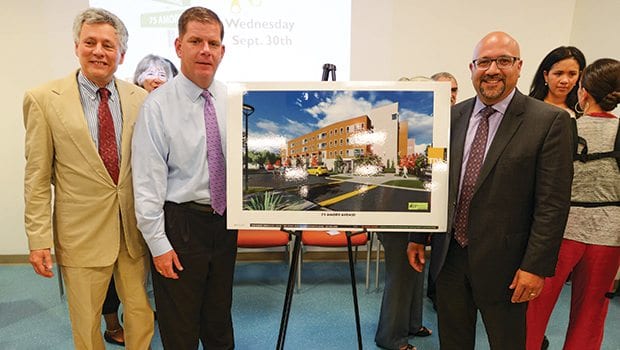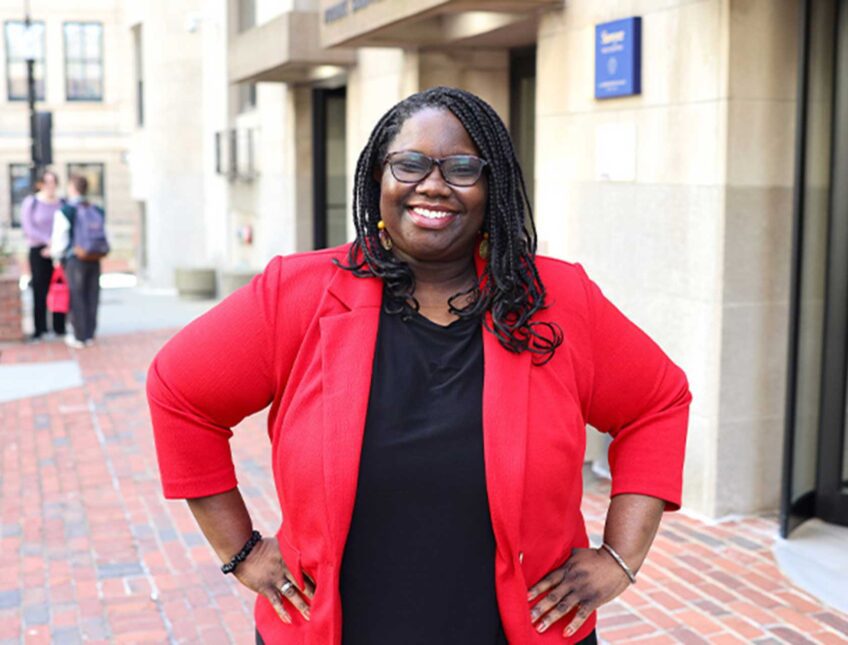
Families and individuals celebrated their new homes September 30 as the ribbon was cut on Jackson Commons apartments. The old Webb Building was rehabilitated into a LEED-certified, mixed-use, mixed-income residential facility with 37 affordable apartments.
But even as Jackson Commons opened the doors to families at the end of last April, hundreds of others wished they had the same luck.
Urban Edge, which developed the property, assigned the units through a lottery.
“We had 2,100 people request applications for 37 apartments,” said Shaina Korman-Houston, Urban Edge project manager. Of those, “there were more than 1,400 eligible applicants for the property.”
The apartments, located at 1542 Columbus Ave, Roxbury, are one- to three- bedroom affordable units, with eight set aside for individuals who were formerly homeless. The building boasts the same level of amenities as market-rate housing, said Korman-Houston, including on-site laundry, a bike rack and a playground. It also has energy-efficient heating and cooling and is designed to maximize sunlight and fresh air flow.
“It was a little bit heart-breaking that 2,100 people needed that many units,” she said, referring the many who requested applications.
Mayor Martin Walsh’s Boston 2030 housing plan, released last October, predicted that as Boston’s population swells that demand for affordable housing will increase.
Surging need, limited options
City officials are well aware that there is a strong demand that is not sufficiently met.
They define housing as within a family’s reach if rent consumes no more than 35 percent of family income. When housing is not designated affordable, this percentage can skyrocket.
“In non-subsidized housing, thousands of families are paying 40-50 percent of their income on rent,” said Joe Kriesberg, president and CEO of Massachusetts Association of Community Development Corporations.
An estimated 35,000 renters in Boston spend more than 50 percent of their income on rent, said Kadineyse Ramize Peña, program associate of Boston Tenants Coalition in a Right to the City press release. Ninety-two percent of these renter households, she said, were very low-income.
But when seeking more affordable housing, families’ options are limited.
In 2013, only 9 percent of rental housing listings were priced at 35 percent of household income for families making $50,000, according to the mayor’s Boston 2030 report. For very-low-income families making $25,000, the amount of attainable rental housing listings dropped to 1 percent.
Not only are many struggling to afford housing now, but more will in the next 15 years.
The Boston 2030 report predicted the number of extremely low-income households burdened by housing costs would increase by 11 percent from 2014 to 2030.
Defining affordable
Housing designated as affordable typically is targeted at families occupying two groups: those making up to 30 percent of the Area Median Income and those making 30-60 percent AMI, said Kriesberg.
This measure compares a family’s earnings to those of all Bostonians as a whole, not to earnings in their neighborhood.
“AMI remains constant across neighborhoods,” said Lisa Pollack, media and public relations director for the Department of Neighborhood Development.
As of June 2015, the U.S. Department of Housing and Urban Development defines 30 percent AMI in Boston as a family of four earning $29,550 and 60 percent AMI as a family of four earning $59,100, according to information posted on the Department of Neighborhood Development’s website.
Financial binds
Like many things, solving the housing problem comes down to money.
“We have two or three new projects that we could be starting next year if there were enough funding for them,” said Richard Thal, executive director of JPNDC. The NDC has started the next step of the Jamaica Plain Redevelopment Master Plan: building a 39-unit affordable housing development at 75 Amory Ave.
In general, housing is expensive to build, and offering it at affordable rates makes it harder for developers to recoup costs.
“It’s a difficult time to develop any housing. Construction costs are very high, land costs are very high,” said Korman-Houston.
An affordable unit costs $350,000-$400,000 to build, said Kriesberg, Korman-Houston and Thal.
Private developers typically make money by charging high rent, a strategy that disappears when rent is capped at affordable levels. To cover the difference between the construction costs and the amount generated from lower rent, state, city and federal government step in with funding.
“The financial reality is developers can’t afford to offer for less without subsidies,” said Kreisberg. “In any given project it’s probably 80-90 percent state and federal subsidies and 10 percent from the city.”
However, government money is not always available. Between 2010-2105, the federal government’s HOME program budget was halved, losing $900 billion, reports TakePart Magazine.
It took over $21 million to build Jackson Commons. To do it, Urban Edge received more than $4 million from Boston and more than $2 million from the state Department of Housing and Development. The remaining funds were cobbled together from multiple other sources.
“It’s got, I think, probably 15 different sources of funding in it. It took a lot of support from the city, from the state, from private partners to put this together,” said Korman-Houston. “This was not an easy project from a financial perspective.”
Building enough new affordable rental housing to meet both current and anticipated demand would cost an estimated $12.6 billion in public resources, claims the mayor’s office in its Boston 2030 report. This is not a feasible number, the report says.
“Given the constraints of space, the high cost of land, declining federal funding, and a finite amount of city dollars available, we must acknowledge that the city cannot build its way out of this problem,” the report states.
Instead, the Walsh housing plan includes building 6,500 new units along with finding ways to keep construction costs down and seizing opportunities to make existing housing stock more affordable, perhaps skirting building costs all together.
Status check
These affordable housing plans appeared in the mayor’s Boston 2030 report released last October. Now a year in, the city declared itself well on the way to meeting these goals.
“New low-income non-elderly starts are currently running at 114 percent of the pace needed to create 6,500 new units by 2030,” states Boston 2030’s most recent quarterly report, released in July.
Permits have been approved on 1,204 affordable units, about 28 percent of which will be designated for those earning below 30 percent AMI. The Department of Neighborhood Development and the Neighborhood Housing Trust also gave funding awards to 18 projects that together will build 500 low-income units and are expected to carry construction costs of $275 million.
New homes and new life
For families like those who moved into Jackson Commons and those still waiting, such efforts to provide affordable housing can make a world of difference.
Plans for revitalizing Jackson Square have been in the works for two decades, said Thal. At last they are coming to fruition with developments like Jackson Commons.
“There’s new life, new people moving in, new businesses moving in,” he said. “It gives people a sense of hope that if you stay with something long enough, good things will come.”

![Banner [Virtual] Art Gallery](https://baystatebanner.com/wp-content/uploads/2024/04/NJ-H_1-150x150.jpg)




